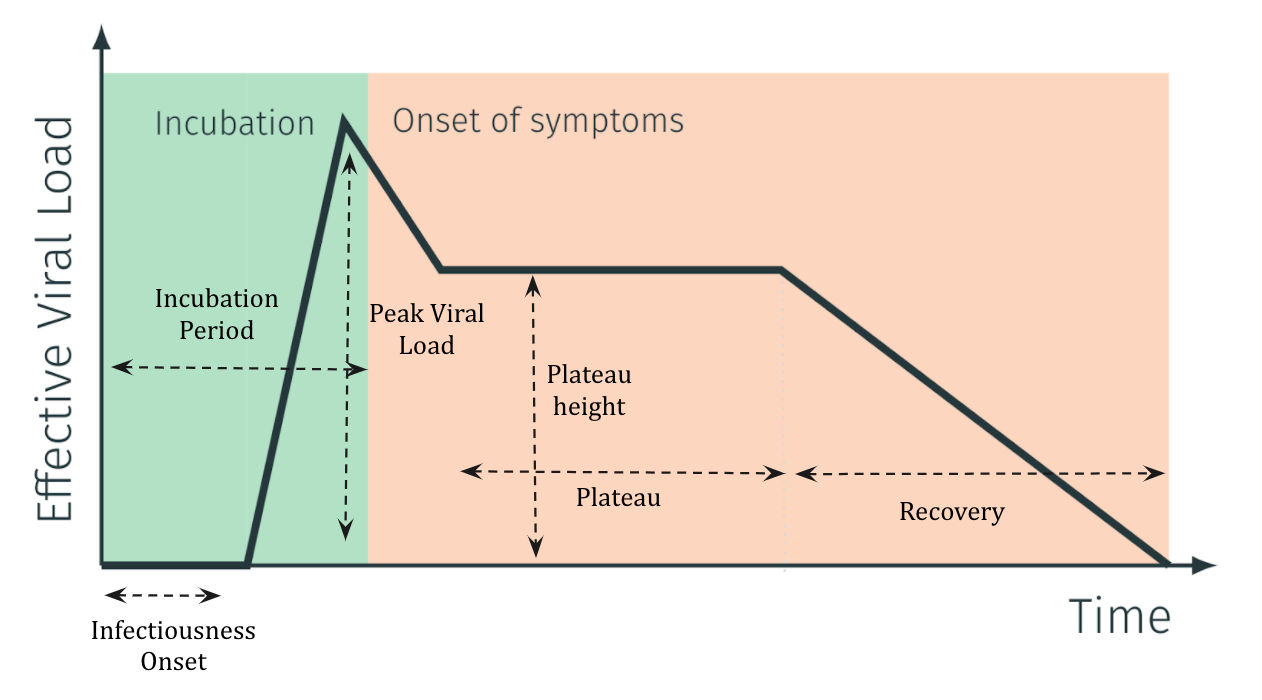Contact tracing as a personalization framework
Thinking of digital test-and-trace as a personalization framework has several advantages, especially when experts across different domains need to come together to address the problem. Such a unified framework can potentially serve the following purposes -
A general framework will need to capture how the virus replicates and spreads from one host organism to another. Epidemiologists and virologists study these mechanisms. Before we bake in the technological constraints, it will help to familiarize ourselves with some basics of the respective fields.
If the virus can infect the host, the host’s state is termed as susceptible. Once the host is infected, the virus keeps replicating until the host’s immunity is strong enough to combat it. The evolving quantity viral load, studied by virologists, is the number of these virus cells inside the host after the infection. However, the host organism starts emitting this virus (e.g., via breath) a short time after the infection when there are enough of them in the body. This state of the host is termed as infectious. At any time, the quantity of virus emitted is proportional to the viral load. For the short period when the concentration of the virus is not enough to be emitted by the host, the state is referred to as exposed. Finally, once the virus has been eliminated, leaving behind the antibodies to prevent future contagion, the host’s state is termed as recovered.
Symptoms do not show up until the incubation period (e.g., mean of 5.3 days for Sars-CoV-2
Although the shape of the viral load curve will vary depending on the individual factors (e.g., age, sex, or pre-existing conditions), we consider a piecewise linear curve shown in Figure 3.
This simplification follows from the empirical study conducted by To et al.

Imagine an oracle that knows everyone’s viral load at any time (wlog, we assume viral load for susceptibles to be zero). It would be relatively easy to control the outbreak without causing much economic disruption by recommending individuals with a non-zero viral load to self-isolate. Therefore, the framework should help us create such an oracle or a predictor that estimates an individual’s effective viral load.
As an input to the predictor, we would want to use relevant data points such as personal attributes, diagnostic results, symptoms, and encounters.
These inputs, however, have associated uncertainties arising from vacillating user behavior or the insufficient research developments.
For example, the RT-PCR test, the most promising diagnostic test for SARS-CoV-2, has a false negative rate of 33% at the viral load peak
Finally, we consider the framework in practice when people with appropriately configured devices (typically, in the form of an app) will use it. We may ask for user information like symptoms or pre-existing conditions through a deliberate user-behavior design of such an app. To respect the privacy of the users, we would want these inputs to never leave the device. Thus, the framework should use such individual information in isolation. Further, to use the peer-to-peer Bluetooth communication protocol, our framework should respect its constraints. As discussed in the previous article, we would want the framework to pass N-bits of information. N’s smaller values make it favorable for user privacy, so we restrict it to 1, 2, 3, or 4.
Since we want to capture the underlying contagion dynamics, the framework should model how much viral load might have been emitted during the encounter.
We would want the communication channel between two user devices to communicate this viral load via N-bits.
However, because the viral load predictions are dependent on inputs that change with time, we must use the communication channel for updates.
Thus, we call these messages warning signals in this series, but are also referred to by risk messages in Bengio et al.
To recap the above discussion, we want the framework to exhibit the following properties :
The ability to adapt to inputs enables the framework to update its prediction as more information flows in the user network. For a scenario where diagnostic tests are administered after the symptoms appear (e.g., if tests are a scarce resource), a framework that relies on symptoms will potentially react faster. Similarly, a predictor relying on warning signals will be even faster. Therefore, we call this framework Proactive Contact Tracing (PCT) due to its ability to generate early warning signals.
The accuracy of these warning signals is dependent on the predictor. The N-bits of the communication channel can also be used to transmit the confidence in these predictions. Due to the uncertainty in predictions, we would want to recommend less restrictive behaviors when appropriate. Thus, PCT is a personalization framework to minimize the true viral load of the population.
In the following post, we explore how to design a reasonably accurate predictor for the PCT framework.